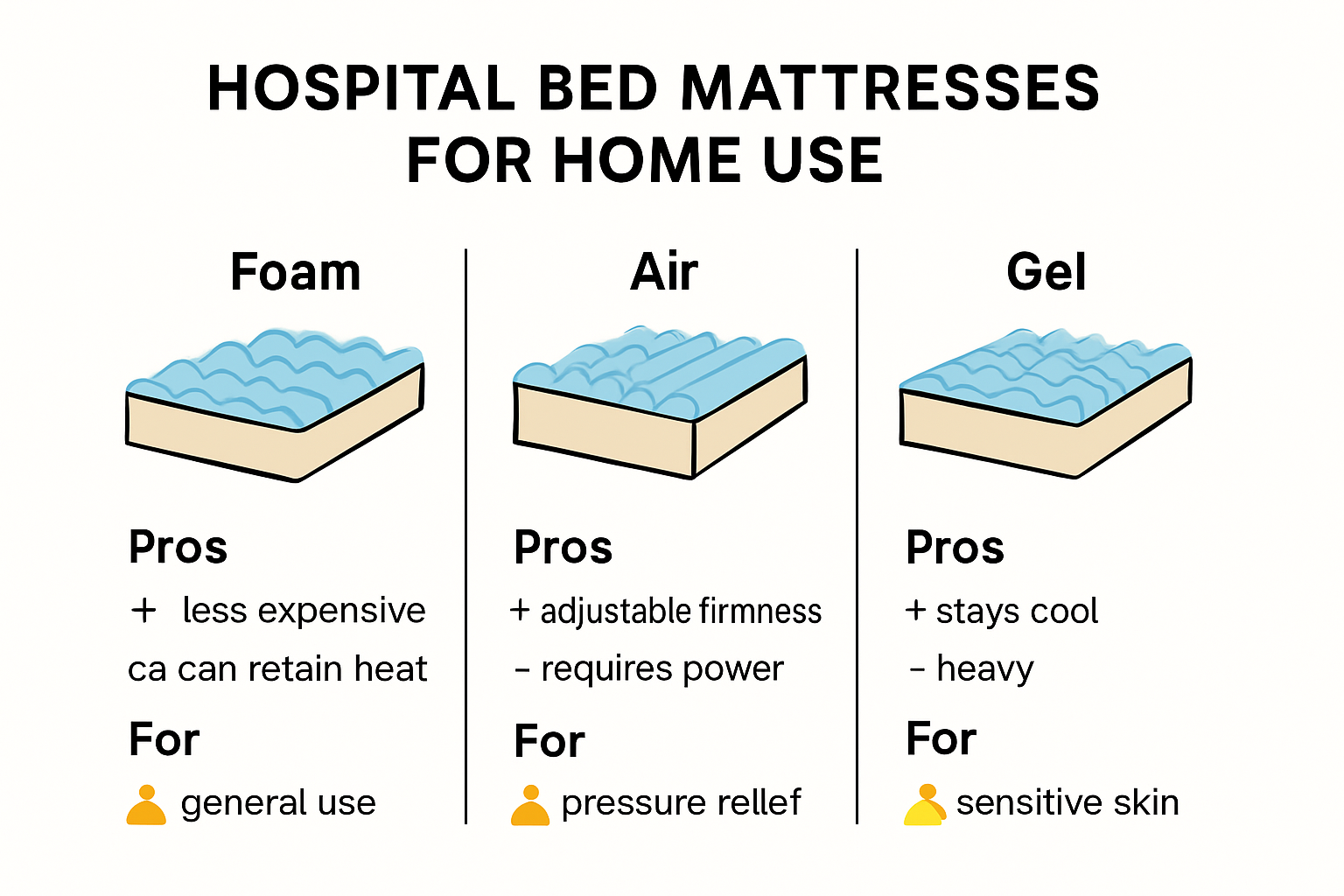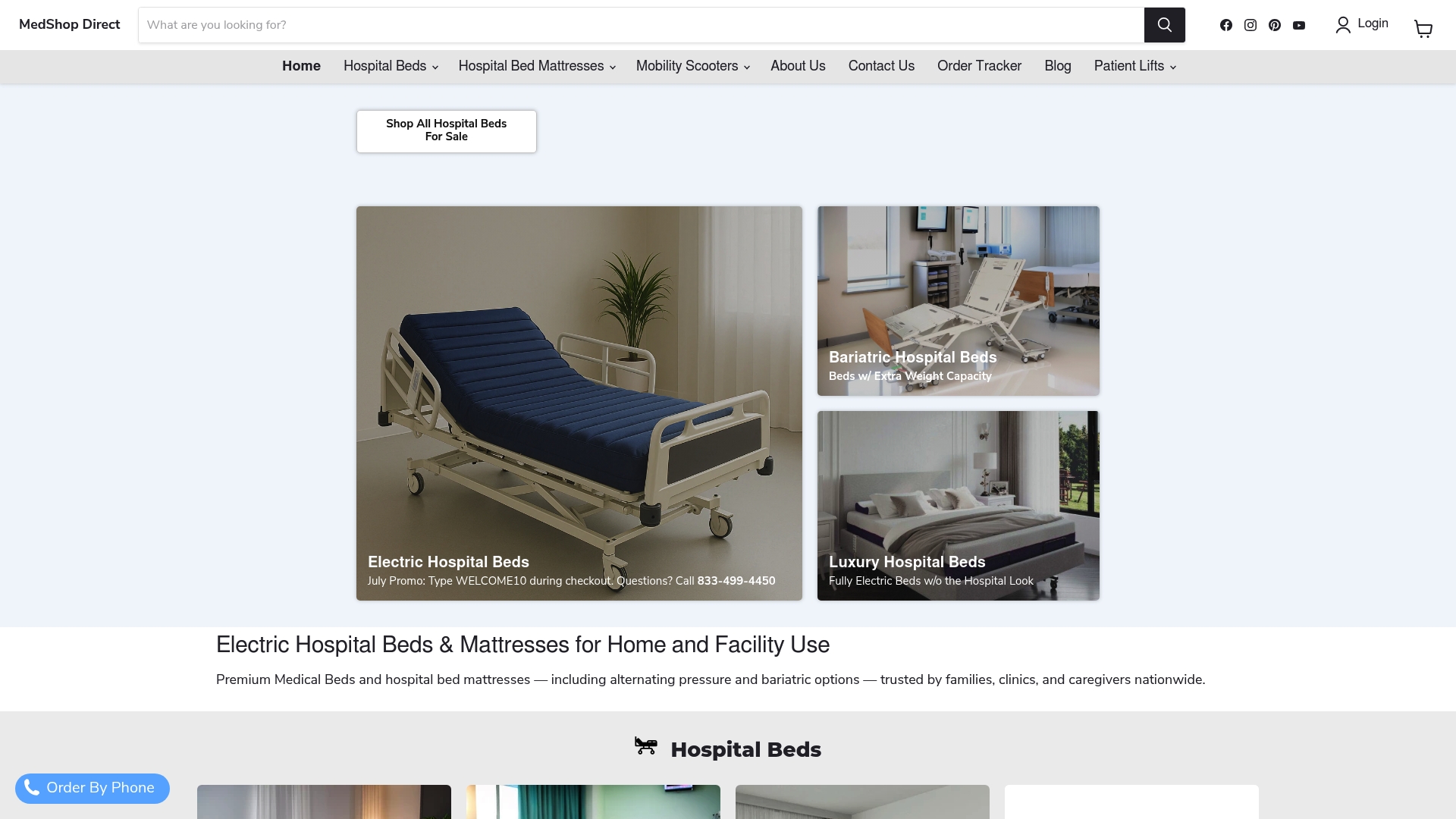

Finding the right hospital bed mattress for home use can make a huge difference in patient comfort and recovery. Here is something that surprises most people. Pressure ulcers can develop in just a few hours if the mattress does not offer enough support. Yet, while advanced pressure relief systems and antimicrobial covers now appear in over 70 percent of modern hospital mattresses, most shoppers still choose based on price alone. The truth is your choice can directly impact health outcomes in ways most never expect.
View All Hospital Bed Mattress, Specialized Alternating Low Air Loss Mattresses for pressure sores, and Heavy Duty Bariatric Mattresses. All include Auto 10% Discount and Free Shipping.
| Takeaway | Explanation |
|---|---|
| Pressure Relief is Essential | Choosing mattresses with advanced pressure relief technologies, such as memory foam or zoned support systems, can significantly reduce the risk of pressure ulcers for patients with limited mobility. |
| Hygiene Features are Crucial | Mattresses should have waterproof and antimicrobial covers that facilitate easy cleaning and prevent infection, essential for maintaining a safe healthcare environment. |
| Compatibility with Adjustable Frames | Ensure the selected mattress is compatible with adjustable bed frames to promote optimal patient positioning and comfort throughout the care process. |
| Individual Needs Assessment | Assessing the specific medical requirements, mobility levels, and potential skin sensitivities of patients is vital for choosing the right mattress type. |
| Routine Maintenance is Key | Regular cleaning, prompt cover replacement, and monitoring for structural integrity are essential practices for extending mattress life and ensuring patient safety. |
Selecting the right hospital bed mattress for home use requires careful consideration of several critical features that directly impact patient comfort, health, and overall quality of care. The best hospital bed mattresses go far beyond simple cushioning and support. The most popular memory foam pressure redistribution mattress for facilities and homecare providers is still the Medacure Proex3 which you can add to cart with an auto 10% applied. The bariatric proex 3 option can also be found here.

Pressure relief represents a fundamental requirement for patients who spend extended periods in bed. According to Johns Hopkins Medicine, prolonged immobility can lead to serious pressure ulcers that develop within hours of constant contact. Advanced hospital bed mattresses incorporate specialized design elements to mitigate these risks.
Modern mattresses utilize multiple pressure distribution technologies. Memory foam designs contour to the patient’s body, redistributing weight and reducing high-pressure contact points. Some advanced models feature zoned support systems that provide different levels of firmness across various body regions. These strategic design approaches help prevent skin breakdown and promote better circulation for patients with limited mobility.
Hygiene represents another crucial consideration for home hospital bed mattresses. Medical Equipment Guide emphasizes the importance of mattresses with waterproof, antimicrobial covers that help maintain cleanliness and prevent potential infections. Top-tier mattresses integrate materials that resist bacterial growth and can be easily sanitized between patient uses.
Ideal hospital bed mattresses feature removable, washable covers made from materials that can withstand repeated cleaning with medical-grade disinfectants. Some innovative designs incorporate silver-ion technology or other antimicrobial treatments directly into the mattress fabric, providing an additional layer of protection against potential pathogens.
The best hospital bed mattresses must seamlessly integrate with adjustable bed frames, allowing for multiple positioning options that enhance patient comfort and facilitate medical care. Research from the National Pressure Ulcer Advisory Panel highlights how proper positioning can significantly reduce complications associated with prolonged bed rest.
Key adjustability features include:
Patients and caregivers should prioritize mattresses that offer versatile positioning capabilities while maintaining consistent comfort and support. The right mattress can transform home medical care, providing both physical comfort and psychological reassurance during challenging health periods.
Ultimately, selecting a hospital bed mattress is about more than technical specifications. It represents an investment in patient dignity, comfort, and recovery potential. By understanding these key features, individuals can make informed decisions that significantly improve home healthcare experiences.

Navigating the world of hospital bed mattresses requires understanding the distinct characteristics of various types available for home use. Each mattress type offers unique benefits tailored to specific medical needs and patient conditions.
Transfer Master highlights that foam mattresses represent a fundamental solution for home medical care. High-density and memory foam designs provide exceptional weight distribution and pressure relief, making them critical for patients with limited mobility.
Memory foam mattresses uniquely contour to the patient’s body, creating a personalized support system that adapts to individual body shapes and weight distributions. These mattresses come in various densities, allowing customization based on patient weight and specific medical requirements. Therapeutic foam mattresses often incorporate multiple layers with different firmness levels, ensuring targeted support for pressure points and promoting better circulation.
Air mattresses represent a sophisticated approach to patient care, particularly for individuals at high risk of pressure ulcers. According to research from Transfer Master, these mattresses utilize advanced technologies like alternating pressure and low air loss systems to continuously redistribute weight and manage moisture.
Two primary air mattress configurations exist for home use:
Specialized medical research indicates gel mattresses offer a cutting-edge solution for patients requiring enhanced pressure management and temperature regulation. These mattresses integrate gel layers that provide superior weight distribution and cooling properties.
Gel mattresses excel in several key areas:
Patients and caregivers should consider individual medical needs, mobility levels, and potential skin sensitivity when selecting a mattress type. Consulting healthcare professionals can provide personalized recommendations tailored to specific medical conditions.
The right mattress transforms home medical care from a challenging necessity to a comfortable, supportive experience. By understanding these mattress types, individuals can make informed decisions that prioritize patient comfort, health, and recovery.
To help you compare the main types of hospital bed mattresses for home use, here is a summary table highlighting their features, benefits, and best use cases:
| Mattress Type | Key Features | Main Benefits | Best For |
|---|---|---|---|
| Foam | High-density or memory foam; multi-layered; contouring support | Excellent pressure relief, custom fit, promotes circulation | Patients with limited mobility, those needing moderate pressure management |
| Air | Alternating pressure; low air loss systems; adjustable firmness | Dynamic weight redistribution, moisture control | High risk of pressure ulcers, frequent repositioning needs |
| Gel | Gel-infused foam or layers; cooling effect; resilient structure | Superior pressure relief, temperature regulation, durability | Patients sensitive to heat, those needing both cooling and advanced support |
Selecting the appropriate hospital bed mattress for home use requires a comprehensive approach that goes beyond basic comfort considerations. The right mattress can significantly impact patient health, recovery, and overall quality of life.
Medical Mattress Experts emphasize the importance of understanding the specific medical requirements of each patient. Individual factors such as mobility level, medical condition, weight, and potential skin sensitivity play crucial roles in mattress selection.
Patients with limited mobility or those at high risk of pressure ulcers require more specialized mattress solutions. Weight distribution becomes a critical factor, with healthcare professionals recommending mattresses that can effectively redistribute pressure and minimize skin breakdown risk. For instance, patients with diabetes or circulatory issues may need mattresses with enhanced pressure relief capabilities that promote better blood circulation.
According to Infection Control Today, mattress selection extends beyond comfort to critical infection prevention strategies. Medical Mattress Experts recommend selecting mattresses with specific hygiene features that protect vulnerable patients.
Key hygiene considerations include:
National Pressure Ulcer Advisory Panel provides guidelines for comprehensive mattress evaluation. Beyond medical specifications, practical considerations ensure the mattress meets real-world home care requirements.
Critical selection criteria include:
Patients and caregivers should involve healthcare professionals in the selection process. A comprehensive assessment that considers medical needs, comfort, hygiene, and practical limitations ensures the most appropriate mattress choice.
Remember that mattress selection is not a one-size-fits-all solution. Each patient represents a unique case requiring personalized consideration. By approaching mattress selection as a holistic process that prioritizes patient health and comfort, individuals can make informed decisions that significantly improve home healthcare experiences.
Proper maintenance of hospital bed mattresses is critical for ensuring patient safety, prolonging mattress lifespan, and preventing potential healthcare-associated infections. A systematic approach to care and maintenance can significantly impact the mattress’s performance and patient comfort.
Centers for Disease Control and Prevention provides comprehensive guidelines for mattress hygiene. Regular cleaning and disinfection represent the first line of defense against potential pathogens and contamination.
Effective cleaning involves multiple strategic steps:
Healthcare professionals recommend cleaning mattress surfaces between patient uses and conducting comprehensive deep cleaning at regular intervals. PubMed Research emphasizes that consistent maintenance directly correlates with reducing healthcare-associated infections.
S2k Hygienic Guidelines provide specific recommendations for mattress cover maintenance. Removable, washable covers offer an additional layer of protection against contamination and wear.
Key cover management practices include:
Waterproof and antimicrobial covers provide enhanced protection, creating a barrier against potential infections and extending the mattress’s usable life.
Beyond routine cleaning, long-term mattress maintenance requires strategic planning. Healthcare Infection Control Practices recommend periodic comprehensive assessments to determine mattress condition and potential replacement needs.
Critical indicators for mattress replacement include:
Patients and caregivers should maintain detailed maintenance logs, tracking cleaning schedules, inspections, and any observed changes in mattress performance. This documentation helps healthcare providers make informed decisions about mattress care and potential replacement.
Ultimately, mattress maintenance is an ongoing process that requires attention to detail, consistent care, and proactive management. By implementing these comprehensive maintenance strategies, patients and caregivers can ensure a safe, hygienic, and comfortable healthcare environment.
When choosing a hospital bed mattress for home use, prioritize pressure relief technology, infection control features, compatibility with adjustable bed frames, and individual patient needs.
Foam mattresses offer comfort and support, air mattresses provide dynamic pressure management, and gel mattresses feature advanced comfort technology. Each type is suited for different medical needs and conditions.
Regular cleaning with EPA-registered disinfectants, using waterproof and antimicrobial covers, and conducting periodic inspections for damages are essential for maintaining a hospital bed mattress.
Look for mattresses with waterproof and antimicrobial covers that can be easily cleaned. These features prevent infection and ensure a hygienic environment for patients.
Struggling to find a hospital bed mattress that truly protects against pressure ulcers and supports your loved one’s comfort at home? The right choice can be the turning point between fast recovery and constant discomfort. As detailed in our article, advanced pressure relief, infection control features, and compatibility with adjustable frames are not extras—they are essential for safe home care. Stop worrying about painful nights, complicated cleaning routines, or the fear of pressure injuries developing faster than you expect.

See how MedShop Direct transforms your search into a stress-free experience. Explore our range of alternating pressure mattresses and hospital bed solutions that combine cutting-edge pressure redistribution with waterproof, antimicrobial covers for exceptional hygiene. Every product is reviewed by real customers and backed by a transparent shopping process. Let us help you choose a mattress that matches your specific needs, so you can focus on healing rather than hassles. Discover your best options and make a truly informed decision at MedShop Direct today.
placeholder